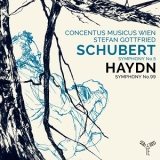Unter seinem künstlerischen Leiter Stefan Gottfried interpretiert das Concentus Musicus Wien zunächst eine farbig-vitale, in den Violinen scharf-frisch klingende 99. Symphonie von Joseph Haydn.
Die Aufnahme der 5. Schubert-Symphonie gefällt mir nicht so gut. Sie ist für meinen Geschmack zu detailverliebt, zu konstruiert, mit einem zu interventionistischen Dirigat. Die Musik fließt nicht frei und entspannt, im letzten Satz sogar etwas atemlos, mit zu viel Drama. Ich will nicht sagen, dass das nicht alles auch gut klingt, aber von der Fünften habe ich meine durch Lorin Maazels Berliner Aufnahme unauslöschlich geprägte Meinung, die sich durchaus aus den Fakten ableiten lässt: Während der Komponist in seiner Vierten (die er Die Tragische nannte) noch unter dem Bann Beethovens stand, ist die Fünfte das Zeichen, dass er sich von eben diesem Beethoven befreien konnte. Sie huldigt den klassischen Meistern Mozart und Haydn mit einer unbelasteten, fröhlichen, melodiösen und kantablen Musik. Und das kann ich in dieser Aufnahme nicht heraushören.
Under its chief conductor Stefan Gottfried, the Concentus Musicus Wien first interprets a colorful-vital and in the violins sharp-fresh sounding 99th Symphony by Joseph Haydn.
I don’t like the recording of the Schubert 5th Symphony as much. It is too detailed for my taste, too contrived, with too interventionist a conducting. The music does not flow freely and relaxed, rather a bit breathless in the last movement, with too much drama. I don’t mean to say that all of this doesn’t sound good, too, but of the Fifth I have my opinion, indelibly shaped by Lorin Maazel’s Berlin recording, an opinion which can certainly be deduced from the facts: While the composer was still under Beethoven’s spell in his Fourth (which he called The Tragic), the Fifth is the sign that he was able to free himself from that very Beethoven. It pays homage to the classical masters Mozart and Haydn with music that is unencumbered, joyful, melodious and cantabile. And I cannot hear that in this recording.






















